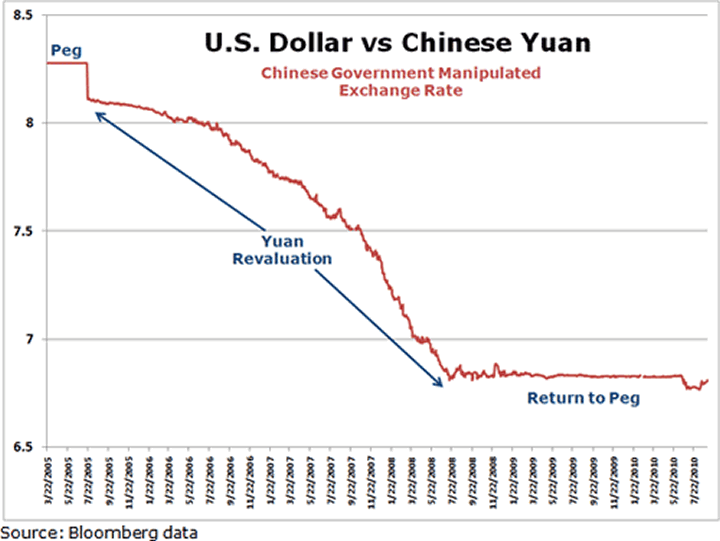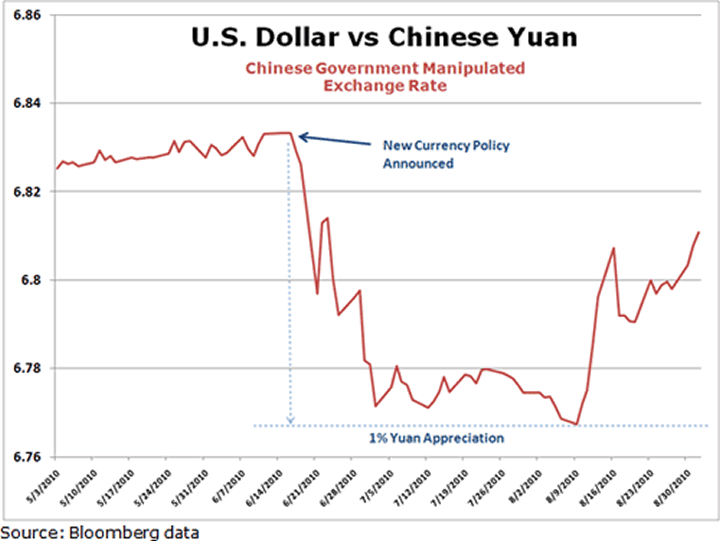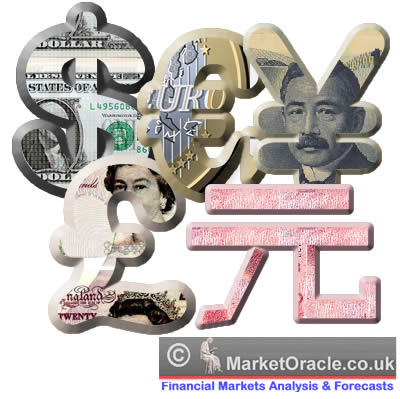China Knows the Fate of the Euro
Currencies / Euro Sep 05, 2010 - 05:41 AM GMTBy: Bryan_Rich
 This week, the U.S. Commerce Department gave China another pass on its currency manipulation, ruling against charges it was undercutting U.S. aluminum makers.
This week, the U.S. Commerce Department gave China another pass on its currency manipulation, ruling against charges it was undercutting U.S. aluminum makers.
This puts China’s currency back on the radar for the politicians and others who, last June, were coaxed into thinking that China was making concessions on its weak currency policy. That’s when China announced they would be de-pegging the value of the yuan from the U.S. dollar.
But all of the bad interpretations surrounding China’s move off of the dollar peg this summer clearly show how confused financial market participants are on this issue …
The mainstream opinion is that China folded to the pressures from the rest of the world. That it opened the door to a big yuan revaluation, which would ultimately allow the currency to appreciate to the market’s estimate of fair value against the dollar.
That’s roughly 40 percent higher than current levels — a move that would go a long way in helping rebalance the global economy, which would be good for long-term global economic stability and growth.
However, that would entail China slowing its own economy at a time when world economies are vulnerable, all for the benefit of others. Not likely.
Instead …
History Is a Good Guide for China’s Likely Course of Action
History shows us that China will continue to act in its own best interest by maintaining trade advantages. This, in turn, will allow the country to keep employing more of its billion-plus citizens, gathering global capital, and boosting its global economic prowess.
Just take a look at the recent history …
The chart below is the government-manipulated exchange rate of the U.S. dollar against the Chinese yuan. A fall in the exchange rate reflects a stronger yuan. You can see where China abandoned the peg against the dollar in 2005 (the red line) under the pressure of tariff threats by U.S. Congress.
Initially the Chinese government allowed the yuan to appreciate by 2.1 percent. In total, over the course of the next three years, the yuan gradually climbed another 15 percent against the dollar.
|
But you can also see in this chart, in late 2008 when the financial crisis was at its peak, China went back to a peg against the dollar (where the red line in the chart starts moving horizontally), which benefited them in two distinct ways …
- It ensured that its most important consumer, the United States, would maintain its purchasing power, even as the U.S. dollar was retreating during much of 2009. And,
- Because of the dollar’s weakness, it created an even greater cost advantage in the global markets for China against its other Asian trading partners, whose currencies climbed sharply last year.
Now, after nearly two years of pegging their currency to the dollar, the Chinese are once again allowing some “flexibility” as they call it.
But there hasn’t been the major one-off revaluation of the yuan the markets have been looking for. Instead, as you can see in this shorter-term chart below, in the two months since moving off of the peg, the yuan strengthened only 1 percent against the dollar.
However, now that the world economic outlook has turned grim again, the yuan has reversed course against the dollar, weakening back toward the value of the recent peg.
|
Given the backdrop I described above, you might ask: Why would China alter its currency policy in the first place?
My guess:
China Wants a Euro Hedge
What’s likely factored most heavily into China’s new currency strategy is the dismal outlook for the euro. Europe is China’s biggest export market. And the falling euro represents a major threat to China’s exports.
The euro lost nearly 20 percent of its value against the dollar from November 2009 to June of this year. All the while, China’s currency was pegged to the dollar. That means European consumers lost significant buying power against not only the dollar, but also against the yuan!
And with the structural problems surrounding the euro, it will likely resume its steep decline and may even result in a break-up of the monetary union — an end to the euro.
China is a highly export dependent economy, and maintaining a cheap currency plays a huge role in their competitiveness. So a continued revaluation of the yuan against the euro doesn’t sit well, especially given the prospects for another global economic slowdown.
|
That’s why China’s currency, under its new policy, trades against a basket of currencies, with about 60 percent less direct exposure to the dollar.
China wants its currency pegged to the dollar when the dollar is weakening. But they don’t want to be pegged to the dollar when it’s strengthening. And the latest policy dramatically diversifies away China’s exposure to a stronger dollar going forward — and consequently, the adverse effects of a weaker euro.
The key take away here: With the evidence of deflationary forces, depressed demand and the growing probability of double-dip recession, global central banks have been exposed as powerless to shorten what increasingly looks to be a long, drawn out period of economic malaise, fraught with economic shocks.
In that world, where sovereign debt defaults, global currency devaluations and a sustained safe haven rally in the dollar look likely, China has one goal: Protect its exports.
Regards,
Bryan
This investment news is brought to you by Money and Markets. Money and Markets is a free daily investment newsletter from Martin D. Weiss and Weiss Research analysts offering the latest investing news and financial insights for the stock market, including tips and advice on investing in gold, energy and oil. Dr. Weiss is a leader in the fields of investing, interest rates, financial safety and economic forecasting. To view archives or subscribe, visit http://www.moneyandmarkets.com.
© 2005-2022 http://www.MarketOracle.co.uk - The Market Oracle is a FREE Daily Financial Markets Analysis & Forecasting online publication.






